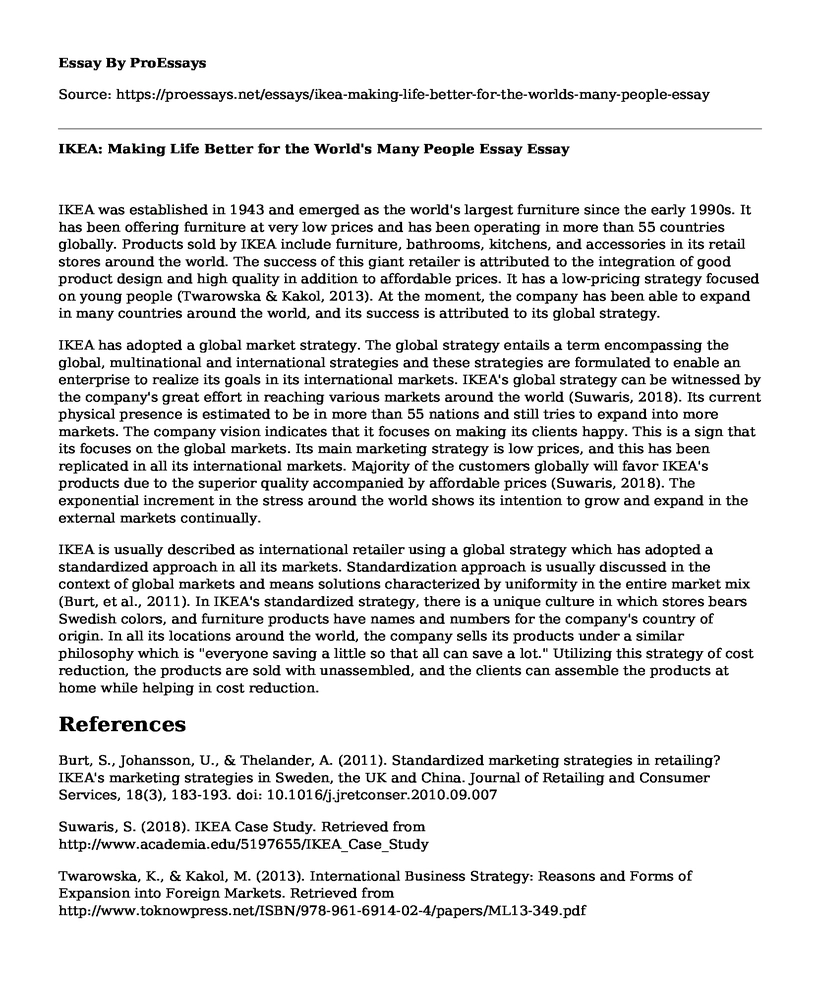IKEA was established in 1943 and emerged as the world's largest furniture since the early 1990s. It has been offering furniture at very low prices and has been operating in more than 55 countries globally. Products sold by IKEA include furniture, bathrooms, kitchens, and accessories in its retail stores around the world. The success of this giant retailer is attributed to the integration of good product design and high quality in addition to affordable prices. It has a low-pricing strategy focused on young people (Twarowska & Kakol, 2013). At the moment, the company has been able to expand in many countries around the world, and its success is attributed to its global strategy.
IKEA has adopted a global market strategy. The global strategy entails a term encompassing the global, multinational and international strategies and these strategies are formulated to enable an enterprise to realize its goals in its international markets. IKEA's global strategy can be witnessed by the company's great effort in reaching various markets around the world (Suwaris, 2018). Its current physical presence is estimated to be in more than 55 nations and still tries to expand into more markets. The company vision indicates that it focuses on making its clients happy. This is a sign that its focuses on the global markets. Its main marketing strategy is low prices, and this has been replicated in all its international markets. Majority of the customers globally will favor IKEA's products due to the superior quality accompanied by affordable prices (Suwaris, 2018). The exponential increment in the stress around the world shows its intention to grow and expand in the external markets continually.
IKEA is usually described as international retailer using a global strategy which has adopted a standardized approach in all its markets. Standardization approach is usually discussed in the context of global markets and means solutions characterized by uniformity in the entire market mix (Burt, et al., 2011). In IKEA's standardized strategy, there is a unique culture in which stores bears Swedish colors, and furniture products have names and numbers for the company's country of origin. In all its locations around the world, the company sells its products under a similar philosophy which is "everyone saving a little so that all can save a lot." Utilizing this strategy of cost reduction, the products are sold with unassembled, and the clients can assemble the products at home while helping in cost reduction.
References
Burt, S., Johansson, U., & Thelander, A. (2011). Standardized marketing strategies in retailing? IKEA's marketing strategies in Sweden, the UK and China. Journal of Retailing and Consumer Services, 18(3), 183-193. doi: 10.1016/j.jretconser.2010.09.007
Suwaris, S. (2018). IKEA Case Study. Retrieved from http://www.academia.edu/5197655/IKEA_Case_Study
Twarowska, K., & Kakol, M. (2013). International Business Strategy: Reasons and Forms of Expansion into Foreign Markets. Retrieved from http://www.toknowpress.net/ISBN/978-961-6914-02-4/papers/ML13-349.pdf
Cite this page
IKEA: Making Life Better for the World's Many People Essay. (2022, May 26). Retrieved from https://proessays.net/essays/ikea-making-life-better-for-the-worlds-many-people-essay
If you are the original author of this essay and no longer wish to have it published on the ProEssays website, please click below to request its removal:
- Big Data Ethics Paper Example
- Research Paper on Conducting Projects in Germany
- Essay Sample on Coca-Cola and Tripple Bottom Line
- Essay Sample on Managing Emergencies and Crisis
- Amazon: Leader in Online Distribution and Adaptive Pricing Strategies - Essay Sample
- Essay on Revolutionizing Business: Technology Advances Reshaping the Work Environment
- Free Essay on Strategic Change in Organizations: Essential for Growth & Competitive Edge







